Mark Sisson's Blog, page 65
August 18, 2020
Ambiguous Loss – It’s Okay to Grieve
 Therapist and professor Pauline Boss coined the term “ambiguous loss” to describe unique types of losses for which there is no closure. Prototypical examples are when a loved one goes missing and is never heard from again, or a parent or partner develops Alzheimer’s disease and slowly ceases to be the person you once knew despite being physically present.
Therapist and professor Pauline Boss coined the term “ambiguous loss” to describe unique types of losses for which there is no closure. Prototypical examples are when a loved one goes missing and is never heard from again, or a parent or partner develops Alzheimer’s disease and slowly ceases to be the person you once knew despite being physically present.
Because these fall outside the realm of “typical loss,” the folks left behind experience more enduring and more complicated grief. Most of us are prepared to deal with losses that are concrete and finite. We have rituals—burials, commemorative tattoos—that help us mark the end of a chapter. When loss is ambiguous, there are no such rituals and no finality. People around us are often ill-equipped to help. They may be confused or put off by the intensity of our grief. They might even regard it as inappropriate or unfounded. It can be tremendously isolating.
It’s no wonder that Dr. Boss asserts that ambiguous loss is the most traumatic and hardest type of loss to face. Ambiguous losses violate our sense of control, certainty, and justice. They shake our identities and disrupt our relationships with other people.
Still, in almost five decades of working with people who have suffered ambiguous losses, she and others have identified concrete steps to help people cope with, and live well after, experiencing ambiguous loss.
Instantly download your Guide to Gut Health
What Types of Situations Create Ambiguous Loss?
As a family therapist, Dr. Boss’s work has mainly focused on two types of situations having to do with the loss of loved ones. In the first, the person is physically gone, but without a (confirmed) death. They are not here but not gone either. Examples include:
Missing persons, kidnapped children
Incarceration
Deployed military personnel
Divorce
Adoption
Immigration
In the second, your loved one is still physically present, yet they have left you in some meaningful way. These people are here but not here. This can occur due to:
Dementia, Alzheimer’s
Traumatic brain injury
Addiction
Certain mental illnesses
What these have in common is relationship. The relationship you once had has been severed, and there is no guarantee (or no realistic chance) it will ever return to normal.
Researchers and practitioners use the ambiguous loss framework to understand other types of situations as well. The experience of loss is entirely subjective. Any time a loss feels complicated or unresolvable, or you believe others won’t acknowledge the depth of your loss, you might experience it as ambiguous. Homesickness might manifest as mild sadness or deep grief. Divorce devastates some and comes as a welcome relief for others. One parent of a transgender child may feel ambiguous loss over the little boy or girl they had known, while the other parent does not.1
Even deaths can trigger ambiguous loss if you feel you can’t grieve freely because:
You weren’t close to the person by societal standards (e.g., employee, social media friend)
Your relationship was illicit or taboo (e.g., former lover)
The nature of the death might elicit shaming or judgment from others (e.g., driving drunk)
Unique Challenges of Grieving an Ambiguous Loss
Psychologically, humans are wired for certainty. We want to control and master our environments. To that end, we need to see the world as fair and just. Ambiguous losses topple those illusions. Not only do people have to deal with the losses themselves, but also the shattering of their worldview.
Not surprisingly, then, ambiguous losses cause profound grief. Grief is nothing like the tidy five-step process you might expect. Even “normal grief” (yes, that really is the technical term) is messy. Beyond that, there are many different types of grief.2 Ambiguous losses may lead to grief that is complicated, chronic, or disenfranchised (when you feel that others won’t validate your grief).3
Then there’s the self-doubt that arises when you aren’t sure whether your grief is appropriate. If your loved one is missing, and you start to grieve, does that mean you’ve given up hope? After a miscarriage, some parents wonder if they are “allowed” to grieve for a child they didn’t get the chance to know. Is their loss “big enough?” Is their pain too much?
These are rhetorical questions, of course, meant to highlight the complexities of ambiguous losses. Too often, we lack the roadmap to deal with these types of situations. When people around us experience ambiguous loss, the discomfort of not knowing the right thing to say means we often don’t say anything. The griever understands that they are not supposed to speak about their loss so as not to make others uncomfortable. We may even get frustrated with others’ grief, wishing they would get over it and move on. Of course, this leads to isolation and further pain.
Coping with Ambiguous Loss
Boss suggests that ambiguous loss, and the complicated grief that it causes, are the hardest losses to cope with. She describes the grief process as “frozen” because the usual advice—find closure—doesn’t apply to these situations.4 People feel like failures because they can’t “get over” their feelings, when really the problem isn’t the persistent grief. It’s the lack of understanding and social support for the grieving person.
Rather than finding closure and moving on, the goal with ambiguous loss is to find a way to live with the ambiguity, develop resilience in lieu of closure, and continue to live a meaningful life despite the sadness.
Concrete Steps You Can Take
When Boss works with someone who is experiencing ambiguous loss, her first step is to name and validate the person’s experience: “What you are experiencing is an ambiguous loss, the most difficult kind of loss because there is no closure.”5 Simply naming the experience often provides relief, as the person sees that their feelings are real and understandable. You can offer yourself this validation. Give yourself permission to feel your feelings without worrying about whether they are okay, too much, or too prolonged.
Find Support
Ideally, you’d be able to rely on friends and family for emotional support, but that may not be the case. Either way, there are other people out there who have had experiences similar to yours. They will be there for you if you seek them out.
You may choose to find a therapist as well. However, Boss stresses that it’s important not to pathologize your grief. In other words, don’t assume something is wrong with you because you’re grieving. Your feelings are legitimate reactions to painful, sometimes horrific, events. If you want someone to talk to, a therapist can be a great option. If you are unable to function or are thinking about self-harm, definitely seek help.
However, friends, family, even therapists shouldn’t push you to “get better,” nor expect your grief be what they consider normal. (This is itself unfair, as no two experiences of grief are identical.) Look for a therapist who has experience with ambiguous loss.
Work on Both/And Thinking
This is also known as dialectical thinking—allowing the mind to hold two contradictory, even seemingly incompatible, beliefs simultaneously. Some cultures are more comfortable with this than others. Americans tend not to be great at it.
Consciously work on accepting this new way of thinking. For example, you might practice telling yourself:
“My partner no longer remembers me, and he is still the person I married.”
“I no longer live there, and that country is still my home.”
“I’ve never met my biological parents, and I still miss them.”
Find Meaning
This doesn’t necessarily mean you have to find meaning in the situation that causes you pain, although it’s great if you can. Rather, you look for ways to continue to live a life that includes purpose and even joy despite the pain. There’s a reason so many people who have lived through trauma go on to help other victims—it provides a sense of purpose. You might find meaning in your work, exercise, a spiritual practice, or a hobby.
These types of activities can also help you reassert your sense of mastery. As you devote your time and energy to a pursuit, you shape the outcome and control a piece of your world once more.
Create Your Own Ritual
If you couldn’t have, or weren’t able to attend, a memorial for someone lost or deceased, do something on your own. It need not be big as long as it feels meaningful to you.
In cases of not-here-but-not-gone losses, people grieve the loss of traditions like family holidays, trips to the summer cabin, or even having nightly dinners together. Ask yourself what types of new rituals you can create that fit your new circumstances. This is another way to find meaning in your present reality, too.
Grief in the Time of COVID
At the beginning of COVID — approximately 7,239 months ago — I wrote that we were individually and collectively experiencing ambiguous loss. That remains as true as ever. Children and parents lost the end of one school year and the beginning of another. You might be grieving for milestones you couldn’t celebrate, lost jobs, loved ones, travel, or simply the world as we knew it in the distant past of January.
It seems to me that many people are either downplaying or unaware of how much the stress and angst of living in 2020 is affecting them. If you’re reading this and coming to see your experience through the lens of ambiguous loss, the same coping tools apply here. Start by acknowledging and validating your experiencing of ambiguous loss. Your feelings are understandable reactions to unfathomable circumstances. Work on finding support where you can and finding new ways to find meaning and control. Practice both/and thinking: “I want to eat out in restaurants, and I understand why they are closed right now.” “I want my kids to have a normal school year, and I know that’s not possible.”
I can’t stress enough that there is no playbook for grief. As I said, the experiences of loss and grief are intensely personal. The goal is to practice self-awareness and self-acceptance so that whatever your situation, you can address it.
Additional resources from Dr. Pauline Boss
Loving Someone Who Has Dementia
Family Stress Management, 3rd ed.
References https://onlinelibrary.wiley.com/doi/abs/10.1111/jftr.12159https://whatsyourgrief.com/types-of-grief/https://whatsyourgrief.com/disenfranchised-grief/https://psycnet.apa.org/record/1999-08128-000https://psycnet.apa.org/record/2010-05509-003
The post Ambiguous Loss – It’s Okay to Grieve appeared first on Mark's Daily Apple.



August 17, 2020
Confidence On Camera for Health Coaches, Entrepreneurs and Public Figures
 Today we welcome guest author Arriane Alexander, Business Coach and Video Expert, and creator of the Lights, Camera, CASH Coaching Program.
Today we welcome guest author Arriane Alexander, Business Coach and Video Expert, and creator of the Lights, Camera, CASH Coaching Program.
How do you stand out from the crowd online?
Whether you are a health coach or an entrepreneur, you are probably trying to figure out how to grow your business and make an impact with your audience. You’re probably aware that creating videos is part of that strategy. The whole world just went virtual, so now is the time to play a bigger game in your business by using video marketing.
Did you know that 80% of people would prefer to learn about a business or product by video versus reading from a blog? And by 2021, video traffic will be 80% of all internet traffic.
Are you ready?
Using videos to grow your audience on Facebook, Instagram and other platforms is essential if you want to: ?
Draw in new clients
Grow your business
Build your brand
Create strong relationships
Launch a new product or program
But, you’re scrolling through Instagram and see all these other people rocking it on videos and a little voice creeps in that says you’re not good enough.
Ugh. I get it.
“My first video was perfect and amazing!” SAID NO ONE EVER
When I first started doing videos many years ago, I had zero confidence. And admittedly, I wasn’t that great on video. The camera was shaky, I was stumbling over my words, and I had no idea how to start or finish my videos. I was so nervous and my videos were all over the place with no structure and no calls to action. One time, I was in the middle of a Facebook Live, and my tripod completely fell over. I was a jumbled hot mess. My thoughts were telling me, you’ll never get this, you’re not good enough, you can’t do it…
But I kept going. I was determined to understand how to create powerful videos, so I tried different things, made many mistakes and finally created a structure for myself. I watched my videos (even though it was painful sometimes) to see what I could do better. And the consistency worked! I got more confident on video and clients started coming to me easily because they had seen my videos and felt like they could trust me.
You need to be willing to get out of your stuffy-adult-I-should-know-how-to-do-this mindset, and get into a beginners mindset, take risks and make mistakes in order to grow your business.
5 Expert Tips to Be Confident on Camera
To get you started, I’m sharing the same pro tips I use with my VIP Lights, Camera, Cash clients every day. I know you are probably working from home and these pro tips will help you feel more confident creating videos in that environment.
You’ll want to address:
Lighting
Camera angle
Who you’re speaking to
Background
Structure
Let’s dig deeper into each of these.
1. Lighting
We must be able to see your eyes, because that’s how we connect with you. How do you create good lighting?
DON’T: Never set your light source behind you, because it will create a shadow on your face and viewers won’t be able to see you. Also, avoid shooting videos in direct sunlight, as it overexposes your face and creates harsh shadows.
DO: Make sure your light source is in FRONT of you, so it reflects on your face. If possible, sit in front of a window or place a light source in front of you. If you need to, order a ring light that will work wonders for your face.
2. Camera Angle
Looking down into the camera can create a double chin that isn’t even there in real life. You can create a sleeker look for your face just by adjusting the camera angle.
DON’T: Set your laptop or phone on your desk or table and look DOWN into the video camera. When your head is tilted down, it brings the energy of the video down, instead of up. It makes you look like you are talking down to the person who is watching you. Plus, you’ll highlight your chin, when you want to focal point to be your eyes.
DO: Raise your laptop or phone to eye level or a little above to create a natural eye line and smooth angle for your jawline. This makes your face and jawline look more streamlined on camera.
How do you do this? Use a box, storage bin, or stack of books to put your laptop on, or use a small tripod for your phone. Be sure your platform is secure so that your equipment doesn’t fall. Creating this good camera angle makes a HUGE difference in how you come across on camera.
3. Speak To One Person At A Time
There are some basic rules of marketing, and one of them is to always speak to one person at a time. Think of TV ads – they are geared towards YOU, not a group of people.
DON’T: A common mistake I see 99% of people making on video is to say “Hi you guys, I’m here to talk about xxx…” But think about it…who is actually watching you? Is it a crowd of people around one phone watching your video? NOPE. It’s ONE PERSON.
DO: Speak to one person only. Imagine your Ideal Client that you are speaking to, and speak to him or her directly. Use words like “you” and “your” so that you are creating a relationship with the person who is watching your video. You want each person watching to feel like you are speaking directly to him or her.
4. Background
We all know most people are doing business at home right now, and space might be tight to create videos, but it is important to be aware of what the camera sees in the background.
DON’T: Have a background that includes your dirty dishes, an un-made bed, or a bathroom door open. Anything that is in the background can be distracting for the viewer, and you want to keep all the focus on yourself.
DO: Make sure the area behind you is tidy and has the least amount of clutter in the view. You can bring your computer or phone closer to your face so there is less background to see. Try to find a space in your home that doesn’t have too much busy-ness going on. Also, you could use a cloth or paper backdrop for videos.
Extra tip: I get a lot of questions about using a virtual background. These can look unnatural and alter the outline of your head and body. The only way this works well and looks really good is if you have a green screen behind you.
5. Structure
It’s easy to get lost in what you are saying while you are creating your videos, so it’s important to have a structure to follow.
DON’T: Turn on your video without an intention and structure of what to say. You might end up rambling on and on in your videos and turn off your viewers.
DO: Be clear about your bullet points before you turn on the camera. Jot them down on a sticky note and put them next to your camera if you need a reminder. Then if you get off track, you can come back to your notes.
Remember, creating videos is a skill, and it doesn’t happen overnight. It’s just like learning a new language or playing the piano. It takes consistency, patience and practice. Be nice to yourself in the learning process and try to have fun even when you make mistakes. We all make mistakes. As you get more confident creating videos, you will reach your audience quicker and easier so they can know you, trust you, and like you.
If you want more support in how to be confident and rock your videos, grab my FREE 7-Day Video Breakthrough Series and Bonus Action Guide: 3 Steps To On-Camera Confidence. This will help you gain the confidence you need to use videos to create the 6 (or even 7!) figure business of your dreams!
About the author: Arriane Alexander, Business Coach and Video Expert
As the creator of the Lights, Camera, CASH Coaching Program, Arriane has helped coaches, consultants, health and fitness experts and other online entrepreneurs take courageous action to create consistent, powerful videos that people actually want to watch. Working with Arriane has been known to increase your business by $750,000 in 6 months, help you actually look forward to turning on a live video, and fill your Mastermind program in just two weeks. Arriane’s video expertise has been featured on Good Morning LaLa Land, The Primal Blueprint Podcast, and The Health Coach Radio Podcast.
When she’s not teaching YOU how to be fabulous in front of the camera, you can also see her on TV working as an actress in some of your favorite shows like S.W.A.T., People vs OJ Simpson, Grey’s Anatomy and Young Sheldon. This cowgirl originally from Oklahoma is also generally working up a sweat on the Santa Monica beach path, making sure the sunshine still feels good.
FREE 7-day Video Breakthrough Series
The post Confidence On Camera for Health Coaches, Entrepreneurs and Public Figures appeared first on Mark's Daily Apple.



August 15, 2020
Tuna Poke Bowl Recipe
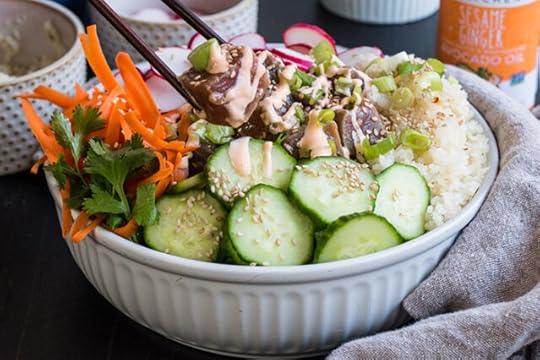 Raw fish, when done right, is one of the most delicious ways to get your protein. You may be more than willing to visit a sushi or poke restaurant, but the idea of making poke bowls at home can be intimidating. Once you try it once, you’ll realize it’s incredibly fast and easy. If you can get your hands on some high-quality tuna, you can make all of your salty, sweet, and tangy poke dreams come true.
Raw fish, when done right, is one of the most delicious ways to get your protein. You may be more than willing to visit a sushi or poke restaurant, but the idea of making poke bowls at home can be intimidating. Once you try it once, you’ll realize it’s incredibly fast and easy. If you can get your hands on some high-quality tuna, you can make all of your salty, sweet, and tangy poke dreams come true.
What Is Poke?
Poke is a traditional Hawaiian dish that’s made with fresh raw fish, usually tuna, marinated in a salty and sweet soy-based sauce. A typical poke bowl starts with a bed of rice, layered with artfully arranged marinated fish and your choice of toppings like avocado, radish, cucumber, sesame seeds, seaweed, scallions, cilantro … the possibilities are endless.
If you’re following a Primal lifestyle, you might hesitate to get behind the ingredients you find in most poke, like sugar-sweetened soy sauce marinades and the high-carb bed of rice. But you probably know by now that living Primally doesn’t mean you have to miss out. With a few simple swaps, we created a poke bowl that won’t derail your progress.
If you can cut a sushi-grade tuna portion into cubes, you can make this tuna poke bowl recipe. Soon, you’ll get creative with toppings and make it your own.
Let’s get started.
Tuna Poke Bowl Recipe
Time in the kitchen: 2o minutes
Serves: 2
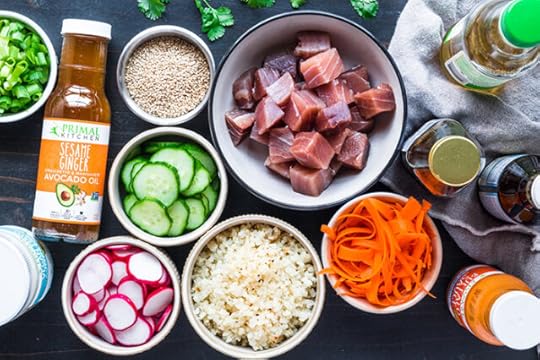
Ingredients
10 oz. cubed yellowfin tuna
1/4 cup Primal Kitchen® Sesame Ginger Dressing
2 Tbsp. coconut aminos
1/2 Tbsp. sesame oil
1 tsp. rice wine vinegar or coconut vinegar
¼ tsp. salt
2 Tbsp. scallions
2 tsp. sesame seeds
1/2 thinly sliced or chopped cucumber
1 bunch thinly sliced radishes (about 1 cup)
1 large carrot sliced into ribbons
3 cups roasted cauliflower rice
2 Tbsp. Primal Kitchen® Mayo (classic or vegan)
1 Tbsp. Primal Kitchen® Buffalo Sauce (or sriracha to taste)
Additional sliced scallions and sesame seeds to garnish
Additional garnishes: avocado, seaweed wraps, chopped mango or pineapple
Directions
In a bowl, combine the Primal Kitchen Sesame Ginger Dressing, coconut aminos, sesame oil, rice wine vinegar and salt.
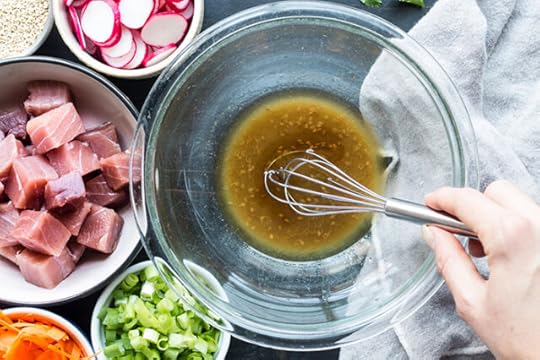 Fold in the tuna along with the scallions and sesame seeds. Allow the tuna to marinate while you prepare the rest of the dish.
Fold in the tuna along with the scallions and sesame seeds. Allow the tuna to marinate while you prepare the rest of the dish.
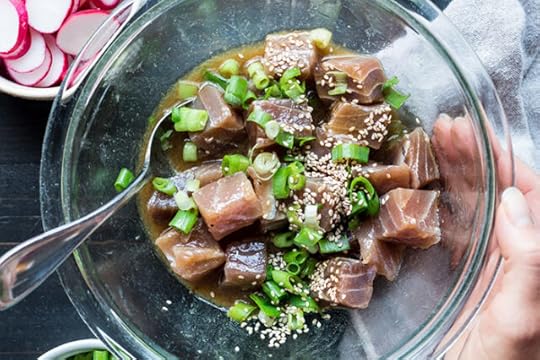
Roast the cauliflower rice in a 375 F degree oven until browned. Slice the cucumbers and radishes and use a vegetable peeler to peel the carrot into ribbons.
Mix together the Primal Kitchen Mayo with either the Primal Kitchen Buffalo Sauce or a squeeze of Sriracha sauce until it reaches your desired spiciness.
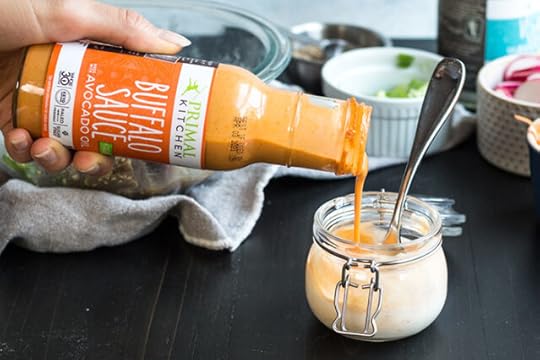
Arrange a bowl with the tuna, raw veggies and cauliflower rice. Top with scallions and sesame seeds as well as a drizzle of the spicy mayo.
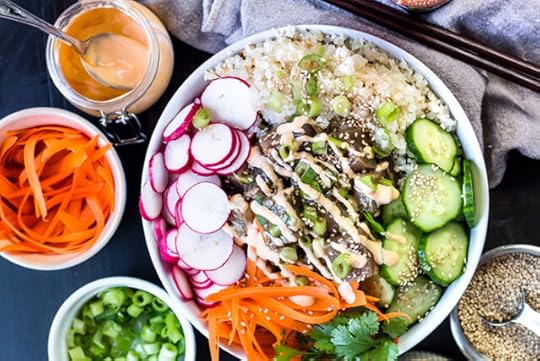
Tips
Always use sushi-grade fish if you are consuming fish raw. Sushi-grade tuna is handled appropriately to ensure raw quality.
If you aren’t a fan of tuna, you can use salmon. If raw fish isn’t your thing, these poke bowls are delicious with cooked shrimp or cooked fish.
Experiment with different toppings for your poke bowl. Add ingredients like sliced avocado, chopped fruit, pickled veggies.. Whatever sounds appealing probably is!
For a fun twist, layer the tuna and veggies in a nori seaweed wrap and eat it that way instead of in a bowl.
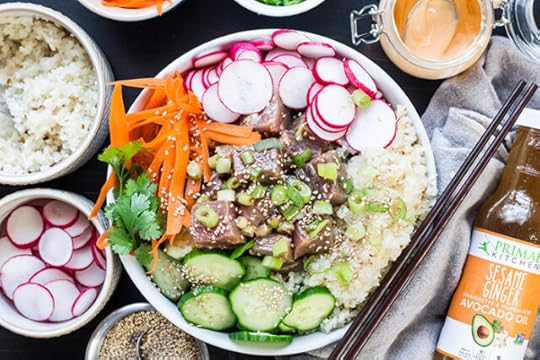
Nutrition Information (1/2 of recipe):
Calories: 500
Fat: 30g
Total Carbohydrates: 19g
Net Carbohydrates: 14g
Protein: 39g
The post Tuna Poke Bowl Recipe appeared first on Mark's Daily Apple.



August 14, 2020
Weekly Link Love — Edition 94

Research of the Week
The American College of Cardiology reassesses its stance on saturated fats.
Psychological stress makes it harder to recover from DOMS.
How a person uses their smartphone can reveal aspects of their personality.
Dietary lectins travel from the gut to the brain of C. elegans worms. Potential Parkinson’s explanation?
New Primal Blueprint Podcasts
Episode 439: Amy Morin: Host Elle Russ chats with Amy Morin.
Primal Health Coach Radio, Episode 73: Laura and Erin chat with Dr. Anna Cabeca about managing menopause.
Media, Schmedia
Interesting Blog Posts
No one knows you like old friends.
Social Notes
Phil Mickelson has been reading this side of the online health community.
Everything Else
Take your morality pills, citizen.
The promise of interferon therapy.
Will llamas save the world, once again?
Things I’m Up to and Interested In
Interesting finding: Adding mass to low-rank pigeons helped them ascend the dominance hierarchy.
I’m not surprised: Media hypes up a few instances of people doing “weird” health things as a huge trend.
I wish the Beatles had done a song about this: A day in the life.
I always think about this: The fact that the components of our food are still mostly unmapped.
We need more of these results to effect real change: More artificial outdoor light, higher rates of teen mental illness.
Question I’m Asking
Would you take the morality pill?
Recipe Corner
Have you ever had a chaffle?
Air fryer sesame cauliflower looks pretty genius.
Time Capsule
One year ago (Aug 8 – Aug 14)
Have I Gone Full Keto? – Well, have I?
Primal Guide to Olive Oil: When and Why To Use It – How to use the green stuff.
Comment of the Week
“You may already personally know this but sharks can sometimes be seen just out from where the waves break and I’d imagine someone floating on the water looks quite like a seal to a shark. Just something to be aware of… Just sayin’.”
-That little dose of fear and uncertainty in the back of your mind (and it’s on everyone’s mind when they’re out there) is part of the allure, I think, Frank.
The post Weekly Link Love — Edition 94 appeared first on Mark's Daily Apple.



August 13, 2020
Ask a Health Coach: Why Pain Doesn’t Equal Gain
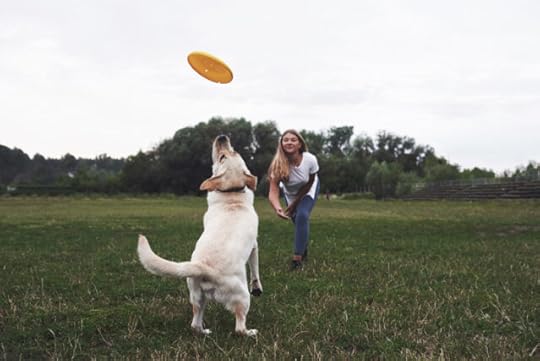 Hi Folks! This week, Erin is navigating the age-old pain versus gain debate, providing strategies for injury-free workouts, ditching the restrictive diet mentality, and the real reason you’re not seeing results. Keep your questions coming over in the Mark’s Daily Apple Facebook group or in the comments below.
Hi Folks! This week, Erin is navigating the age-old pain versus gain debate, providing strategies for injury-free workouts, ditching the restrictive diet mentality, and the real reason you’re not seeing results. Keep your questions coming over in the Mark’s Daily Apple Facebook group or in the comments below.
Raymond asked:
“I’m struggling to lose the last 10 pounds, mainly because I can’t be as active as I need to be. Every time I try to exercise or do strength training, I end up in pain. Part of me doesn’t want to do it because I know I’ll be miserable for a few days afterward. Any tips on exercising pain-free?”
It sounds like you’re clear on your end goal: to lose those last 10 pounds. But you’re also struggling with body pain every time you work out. I hear you Raymond. Pain is no fun. Thankfully, you don’t have to subject yourself to it in order to lose weight.
The whole no pain, no gain mentality is total BS. Punishing yourself just to reach your end goal is never a good plan. But let’s take a step back and look at your situation for a minute. You say every time you try to exercise or strength train, you end up in pain. Is that true? Is it every time? Or is it only when you do certain exercises or do them for a certain amount of time?
We often look at workouts as lifting dumbbells, taking a class, or going for a run. Or we overdo it on a consistent basis because we’re comparing our workouts to that of someone on Instagram or in our circle of friends. All of which has the ability to create undue pain. And not just physical pain.
Just remember that any form of movement has the potential to lead to weight loss, or as I prefer to say, fat loss. And a big part of how successful you’ll be starts with how you perceive your efforts.
So, I’ve got to ask. Do you look at your workouts as a chore that might finally get the scale down 10 pounds? Or is exercise something you actually enjoy doing? It’s possible that by reframing the way you see your workouts, you could actually diminish your perceived pain.
In one study, researchers saw a major distinction between spinal cord injury patients who were motivated to be physically active by positive versus negative incentives. Positive incentives were things like seeing an improvement in mood either during or after the activity and feeling satisfied with their accomplishments. Negative incentives were all motivated by fear or obligation, often causing the participants additional discomfort and pain.1
Back in the day, our ancestors stayed active by chasing antelope so they’d have dinner or they walked to the nearest spring to get fresh water. There was no selective pressure to find joy in exercise because it simply needed to be done to survive.
Thankfully, these days, we have the choice to work out in a way that resonates with us. So, if daily strength sessions bring on the worst DOMS, see how you can integrate shorter microworkouts into your day. If sprints feel like a chore, try chasing your kids around at the park. You get the picture.
My point is, changing your body often starts by changing your relationship with physical activity. And moving from the idea that pain is the only way to achieve gain, can be as close as finding joy in your workouts instead of struggle.
—
Anne asked:
“I’ve recently noticed that my clothes aren’t fitting the way they used to. I’ve tried restricting all sugar and carbs, and I’m thinking about getting one of those food scales. What do you recommend to get my eating under control?”
I think a lot of us are feeling the pinch of being stuck at home with a new routine and a kitchen full of snacks. You’re struggling to button your favorite pants. Your shirts are pulling slightly. Maybe you’re a little softer in the middle.
And I get it, the first response to unexpected weight gain is often to restrict the heck out of your diet. Banish all carbs! Burn all the treats! Count every calorie that comes near your mouth!
Our society tells us that weight gain is something to be ashamed of and reverse as quickly as possible. We’re told that we need to feel bad and that we should most definitely panic.
When you’re upset with your body, extreme measures can feel like the only solution. In your mind, your eating habits might feel out of control. And the only way to course-correct is to suffer — eliminating carbs, sugar, joy…
Listen, getting back on track shouldn’t equal punishing yourself. As I’ve said before, the body is an amazing, miraculous organism that deserves to be appreciated. That’s why doing anything that comes from an opposing point of view is a recipe for disaster.
Regaining control suggests a forceful wrangling of your habits. Sure, you need to have accountability, but using harsh techniques that come from a place of hate instead of love will eventually derail your relationship with your body even further. You didn’t gain the weight overnight. Therefore, a quick and unnecessarily harsh plan of attack won’t get you where you want to go.
My recommendation is to be realistic and non-dramatic. Set goals that are actually attainable for you for the long term. If you want to lose 10 pounds, start with 1 pound. If you want to stop snacking, eat more protein during the day. If you want to exercise more, get outside and walk. And most importantly watch your self-talk. If you’re unhappy with how your clothes are fitting, try not to focus on the negative. Instead, reframe your situation to see what you can be grateful for.
Rob asked:
“I eat mostly Primally and have been fit my whole life. There’s just that last little bit of extra around the middle that won’t seem to budge. I do tons of planks and crunches, but what other exercises can I do to target my mid-section?”
More doesn’t always equal more. You know what I mean Rob? Hours of planks, crunches, twists, and dead bugs might strengthen your core, but I don’t think more exercises are what you need.
If you’ve been trained in the unfortunate art of no pain, no gain, you might think your lack of results is because you’re not pushing yourself hard enough. Let me offer another perspective.
You mention that you’re “mostly” Primal. What does that look like for you? Grains here and there? A few beers on the weekends? Baked goods on holidays? Primal is designed to be a lifestyle, so you can enjoy the occasional beer or baked good. The problem arises when “occasional” turns into “regular” or it turns into an excuse to eat unhealthily whenever the mood strikes.
If you’re telling yourself you worked out today so you can indulge in a sleeve of Oreos, no amount of crunches are going reverse to the extra calories and garbage ingredients you just consumed. To really reduce midsection fat and the accompanying bloat, try cutting out all refined carbs, sugar, and alcohol for two weeks and see what happens. It’s pretty tough to rock a spare tire if you’re primarily getting your calories from protein, healthy fats, and produce.
Do you buy into the no gain, no pain mindset? Tell me how it’s worked for you — or against you in the comments below!
References https://www.ncbi.nlm.nih.gov/pmc/articles/PMC6136354/
The post Ask a Health Coach: Why Pain Doesn’t Equal Gain appeared first on Mark's Daily Apple.



August 12, 2020
Is Stevia Safe, or Bad for You? Everything You Need to Know
 After cutting back on sugar and carbs for a while, you understandably start to miss sweets. A common misconception is that you have to skip sweets to meet your goals, which isn’t the case at all. There are plenty of sugar alternatives that fit within the Primal and keto lifestyles, and stevia is one of them.
After cutting back on sugar and carbs for a while, you understandably start to miss sweets. A common misconception is that you have to skip sweets to meet your goals, which isn’t the case at all. There are plenty of sugar alternatives that fit within the Primal and keto lifestyles, and stevia is one of them.
Stevia is widely used in the low carb community to satisfy sugar cravings or simply add a touch of sweetness to a hot beverage or dessert, but should it be? What is stevia? Is it safe? What is its effect on insulin, if any, and does it have a place in a Primal Blueprint eating strategy? Let’s investigate.
What Is Stevia?
A lot of people categorize stevia as an artificial sweetener, but it’s important to note that stevia is not an artificial sweetener at all – it’s a plant-derived natural alternative to sugar.
Stevia is an herbaceous family of plants, 240 species strong, that grows in sub-tropical and tropical America (mostly South and Central, but some North). Stevia the sweetener refers to stevia rebaudiana, the plant and its leaves, which you can grow and use as or with tea (it was traditionally paired with yerba mate in South America) or, dried and powdered, as a sugar substitute that you sprinkle on. It’s apparently quite easy to grow, according to the stevia seller who tries to get me to buy a plant or two whenever I’m at the Santa Monica farmers’ market, and the raw leaf is very sweet.
Instantly download you Guide to Gut Health
The Sweet Compounds in Stevia: Stevioside and Rebaudioside
Most stevia you’ll come across isn’t in its raw, unprocessed form, but in powdered or liquid extract form. The “sweet” lies in the steviol glycosides – stevioside and rebaudioside – which are the natural compounds isolated in these extracts. Some products use just one, while others use both stevioside and rebaudioside. Stevioside is the most prevalent glycoside in stevia, and some say it provides the bitter aftertaste that people sometimes complain about; rebaudioside is said to be the better tasting steviol glycoside, with far less bitterness.
Most of the “raw or natural” stevia products use the full range of glycosides, but the more processed brands will most likely isolate one or more of the steviol glycosides. The popular Truvia brand of stevia products uses only rebaudioside, as do both PureVia and Enliten. Different brands provide different conversion rates, but compared to sucrose, stevioside is generally about 250-300 times as sweet and rebaudioside is about 350-450 times as sweet.
Is Stevia Safe, or Bad for You?
The government has approved only isolated steviol glycosides as safe to use in food. Whole or crude stevia is not Generally Recognized as Safe (GRAS) according to government standards.1
And, there are limits. According to government standards, you should not exceed a daily intake for stevia glycosides of 4mg per kg of bodyweight.2 This is due to lack of safety information, not so much the presence of known harmful effects.
Does Stevia Affect Insulin?
I wrote an extensive piece on whether artificial sweeteners spike blood sugar a while back. There is one in vitro study that showed stevioside acts directly on pancreatic beta cells to stimulate insulin secretion and another which shows similarly insulinotropic (insulin-producing) effects of rebaudioside, which may give you pause.
Insulin secretion sounds like an insulin spike, no? And since we tend to be wary of unneeded insulin spikes, maybe we should avoid stevia. It’s not so simple, of course. For one, this was an in vitro study, performed in a super-controlled laboratory petri dish type setting; this was not an in vivo study of animals or people eating stevia in a natural, organic way. The results of in vitro studies do not always match results when you try to replicate them in vivo (in a person).
Secondly, insulin secretion isn’t necessarily a bad thing. I mean, we need it to shuttle nutrients into cells, and we’d die without it. As I mentioned in the dairy post a while back, insulin is millions upon millions of years old. It’s been preserved throughout history because it’s an essential hormone. It’s not always the bad guy, especially if your insulin sensitivity is where it should be.
In fact, the evidence is mounting that stevia actually is an insulin sensitizer that can aid in glucose tolerance and clearance after a meal. The Japanese have been using stevia for decades in the treatment of type 2 diabetics. Let’s look at a few recent studies. In fructose-fed rats, a single instance of oral stevioside increased insulin sensitivity and reduced postprandial blood glucose in a dose-dependent manner. The same study also found that diabetic rats given stevioside required less exogenous insulin for the same effect. Taken together, these results suggest that stevia may not just be a good sugar substitute for diabetics, but an effective supplement for treatment of their insulin resistance.3
Another study looked at the postprandial effects of stevia, sucrose, and aspartame in human subjects. Compared to sucrose eaters, stevia eaters showed lower postprandial (after eating) blood sugar levels. Compared to both sucrose and aspartame eaters, stevia eaters had far lower postprandial insulin levels. Furthermore, eating stevia did not induce increased appetite throughout the day, indicating stable blood sugar and satiety levels.4 Another strike in stevia’s favor.
Stevia-sweetened recipes:
Matcha Mint Keto Green Smoothie Recipe
Stevia Side Effects
Allergy to stevia has been reported, but it is rare.
Most people do not experience side effects when using stevia, but some people do experience effects like:
Stomach Issues
Nausea
Gastrointestinal discomfort
Bloating
Diarrhea
Most often these effects are from using stevia that is mixed with sugar alcohols, like erythritol or xylitol. If you can tolerate sugar alcohols, you will probably be okay using combination stevia and sugar alcohol products. To be sure, start slow, and watch for symptoms.
Diabetic Concerns
Stevia is considered safe for the diabetic population, but sometimes it is combined with ingredients that affect carb count, like dextrose and maltodextrin. If you’re diabetic, check your ingredients label and carb counts before adding it to food.
Fertility Issues
Historically, stevia has been used as a form of birth control, so use of stevia may contribute to fertility issues.5 That said, it is not a reliable form of birth control, so it’s not advisable to use it for that purpose.
Any Other Effects?
There are other potential benefits to using stevia unrelated to its apparent benefits on glycemic control. Here are a few studies I was able to dig up:
When combined with inulin, a soluble prebiotic fiber, low-dose stevia increased HDL while lowering overall lipids in male rats.6 Alone, low-dose stevia lowered cholesterol without the potentially beneficial effect on HDL. It’s also useful to note that high-dose stevia negatively affected some toxic parameters – so don’t eat spoonfuls of stevia (not that you would) – but long term low-dose stevia was deemed safe.
Lipid numbers are fun and all, but we’re really interested in avoiding atherosclerotic plaque buildup. In mice treated with stevioside, oxidized LDL was reduced, overall plaque volume was reduced, and insulin sensitivity increased. Overall, atherosclerosis was reduced in the stevioside-treated mice.7 I couldn’t dig up exactly how they were “treated,” however, but they were given doses of 10 mg/kg.
In another study, mice memory was impaired by administration of scopolamine, an anticholigernic found in the intensely hallucinogenic jimson weed (or devil’s weed) and datura. Impaired mice were given oral stevioside (250 mg/kg) and tested for memory retention. Memory deficit was largely reversed with administration of stevioside, which also reduced the brain oxidative damage caused by scopolamine.8 Clinically relevant? Perhaps not, but it’s interesting.
A two-year randomized, placebo-controlled study of Chinese patients with mild hypertension (which a rather large swath of society probably suffers from) found that oral stevioside intake significantly reduced systolic and diastolic blood pressure.9 Patients either took a 500 mg capsule of stevioside or a placebo three times a day for two years. The hypertension situation improved across the board and no downsides were reported or detected. Also of note is the fact that slightly more patients in the placebo group developed left ventricular hypertrophy, a pathological thickening of the heart muscle. Of course, another study using far lower doses (up to 15 mg/kg/day) found no anti-hypertensive effects,10 so it appears that the dose is key. Maybe somewhere in the middle works well, as one study in hypertensive dogs showed: they used 200 mg/kg to normalize blood pressure in the canine subjects.11
We can think about stevia as a Primal sugar alternative with some potentially beneficial effects. Kind of like cinnamon or turmeric, we don’t consume it for the calories or as literal fuel for our bodies, but for flavor, variety, and, possibly, the health benefits. It may induce insulin secretion, but it increases insulin sensitivity, reduces blood glucose (i.e., the insulin is doing its job), and does not increase appetite. It’s been used by humans for hundreds of years and by diabetic patients in Asia for decades. I’m a fan of the stuff and recommend it as a Primal way to satisfy a sweet tooth.
What do you guys think of stevia? Love it? Hate it? Have you ever used its potential therapeutic effects? Let me know in the comment section!
References https://www.fda.gov/about-fda/fda-basics/has-stevia-been-approved-fda-be-used-sweetenerhttps://www.ncbi.nlm.nih.gov/pmc/articles/PMC5591507/table/Tab1/http://www.ncbi.nlm.nih.gov/pubmed/16278783http://www.ncbi.nlm.nih.gov/pubmed/20303371https://pubmed.ncbi.nlm.nih.gov/17744732/http://www.ncbi.nlm.nih.gov/pubmed/21089163http://www.ncbi.nlm.nih.gov/pubmed/20010904http://www.ncbi.nlm.nih.gov/pubmed/20871768http://www.ncbi.nlm.nih.gov/pubmed/14693305http://www.ncbi.nlm.nih.gov/pubmed/16775813http://www.ncbi.nlm.nih.gov/pubmed/12444299
The post Is Stevia Safe, or Bad for You? Everything You Need to Know appeared first on Mark's Daily Apple.



August 11, 2020
Getting Back on the Wagon
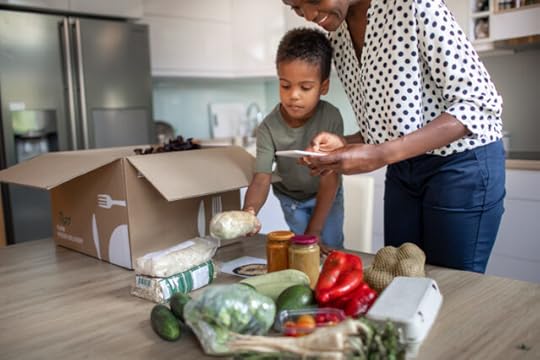 Things are going great. You’re eating well, moving your body regularly, lifting heavy things, getting good sleep. Then wham! Something happens, and all your best laid plans are out the window. Maybe it’s a crisis at work, the loss of a loved one, a vacation, or, I don’t know, a global pandemic that changes everything. Sometimes it’s nothing memorable, you just sort of… stop trying.
Things are going great. You’re eating well, moving your body regularly, lifting heavy things, getting good sleep. Then wham! Something happens, and all your best laid plans are out the window. Maybe it’s a crisis at work, the loss of a loved one, a vacation, or, I don’t know, a global pandemic that changes everything. Sometimes it’s nothing memorable, you just sort of… stop trying.
What do you do when you realize you’ve fallen off the wagon?
It’s simple. You pick yourself up, dust yourself off, and climb back on.
Were You Really “Off the Wagon?”
Before talking about how to get back on the wagon, it’s worth asking yourself if you were really off in the first place. It’s one thing to lose your way for a while and make choices that erode the health gains you’d made. It’s another to allow yourself to enjoy a decadent dessert at a fancy restaurant, or to have one stressful week at work that leaves you with no time to meal prep or go to the gym.
There’s no set timeline where you can say, “Now I’m officially off the wagon.” There’s no set number of lenient meals, sweet treats, or sedentary days in a row that determine that you’re not “in” a healthy lifestyle anymore. It’s subjective. There’s no membership card.
The point of this exercise is to avoid the temptation to make a big deal over minor blips. Diet culture is all about “cheating” and “failing” and “starting over.” That’s not the spirit of living Primally. We strive to make day-to-day choices that support health while also allowing for life to happen.
It’s the 80/20 principle, remember? Self-flagellation or shame spirals aren’t part of the plan. Sometimes dessert is just dessert.
That said, there are times when you’ve well and truly fallen off the metaphorical wagon, and you’re ready to get back on track. Let’s break this down into three parts: what you need to do immediately, in the short term, and making plans for the long term.
Stay on track no matter where you are. Instantly download your Primal and Keto Guide to Eating Out
What to Do Today to Get Back on the Wagon
Just start. Make your next meal a healthy and satisfying one. Pick one of the Primal Essential Movements and do one set. Set a bedtime alarm on your phone and actually hit the sheets when it goes off. Whatever success looks like to you, take one concrete step. That’s it.
Fasting to Get Back on the Wagon
“Start by fasting for a day”—it’s common advice. I’m of a couple minds here.
On the one hand, fasting offers a quick jumpstart. A 24-hour fast (eating dinner one night and then not eating again until dinner the following day, for example) burns through glycogen, accelerating fat burning and putting you on the road to ketosis if that’s your plan. It’s also symbolic, marking your commitment to making today a changing point.
On the other hand, this probably isn’t a good strategy for people who have struggled with disordered eating behaviors in the past. Fasting isn’t inherently problematic, but it can be, such as when someone gets into a cycle of “cheating” then fasting to atone. Also, if you’ve been eating a standard high-carb diet for a while now, you might not be equipped to fast comfortably, at least not for 24 hours. Don’t do it if you’re likely to get discouraged and quit again if you find yourself white-knuckling it through the first day.
If fasting isn’t your thing, no problem. A high-intensity exercise session also burns through glycogen and ramps up fat burning, especially if you don’t replenish with carbs after. You can commemorate your first day by starting a new journal, circling the day on your calendar in red marker, preparing a special meal, making a public commitment to friends and family, or hiring a health coach. Or, as I said, you can just take the first step and not look back.
If fasting does appeal to you, a shorter fasting window, say 16 hours, is also fine. There’s no reason to go longer; a three-day long fast is overkill for this purpose. Twenty-four hours is plenty.
Bask in Your Initial Victory
Once you’ve eaten one healthy meal or done one workout, congratulations, you’re back on track. Now you have to stay on track, but take a minute to commend yourself.
If your inner critic tries to tell you that you won’t really be back on the wagon until you string together 30 sugar-free days, or you’re deadlifting your previous personal best, shut that voice down. Those are great goals, but you don’t have to achieve them before you are allowed to feel proud that you took the first step.
What to Do in The Short Term to Stay on the Wagon
Once you’ve taken that first step, there’s more work to be done. You don’t want to immediately veer off course again! This means getting some systems in place to keep you moving in the right direction.
Start Building Better Habits
Building better habits boils down to this: Make it easier and more rewarding to do the things you want to do. Make it harder and less appealing to do the things you don’t want to do.
Simple, right? Sure, but not always easy. Start by identifying some basic things that, once done, will increase your chances of success. Things like:
Stocking your fridge with on-plan foods, and tossing or donating foods you don’t want to be eating
Picking a few basic recipes to get you through the first few days, or starting your week with a meal prep
Getting your home workout equipment out of the closet and putting it someplace prominent
Buying those new running shoes and leaving them where you see them first thing in the morning
Moving the TV and the phone and tablet chargers out of your bedroom
Ask yourself:
What is my biggest obstacle, and what can I do today to remove that obstacle, or at least make it easier to avoid?
What are two or three things that I can do today to make it easier to stick to my goal?
Do those.
For more guidance on building better habits:
6 Concrete Ways to Rewire Your Brain for Successful Habit Change
How to Develop Good Habits
The Definitive Guide to Breaking Bad Habits
Keep A Journal, Food Log, or Calendar
This is optional but recommended. Keeping written track of your behavior is uber-helpful for two reasons. One, it gives you a visual representation of your progress. Just like earning gold stars in kindergarten, you get positive reinforcement from seeing your “good days” accumulate. Two, it allows you to troubleshoot when necessary.
Basic food and exercise logs work well for accountability. They’re even better when combined with journaling about your internal states—hunger, stress, emotions—plus sleep, menstrual cycle, and any other relevant details. The more info you have, the easier it is to spot patterns and make connections. For example, you might learn that carb cravings increase at certain times of your cycle, so you decide to experiment with carb-ups. Or, you might realize you often eat poorly two days after a bad night’s rest. That tells you that you need to work on sleep, not just diet per se.
What to Do in The Longer Term to Stay on the Wagon
One silver lining to falling off the wagon is that it’s always a learning opportunity. That’s what we should all be doing—learning and adapting. It doesn’t mean you’ll never fall off the wagon again, but hopefully you can avoid repeating the same patterns over and over.
Sometimes it’s obvious what happened. You went on vacation, or got sick and stopped working out, but never returned to your healthy habits. Other times it takes some more digging and soul searching to understand how you got derailed (again). It’s never just a lack of willpower or desire. There’s a root cause that needs to be addressed.
Some common reasons people fall off the wagon are:
Caving to social pressure
It’s hard to stay on track when you’re surrounded by naysayers, or if you’re frequently in situations where your willpower is tested. Develop strategies that allow you to deal with these people or situations constructively, or avoid them if you must.
Not managing stress appropriately
If you change your diet, but everything else about your modern, high-stress life stays the same, you’ll inevitably falter.
Digging yourself into an energy hole
Not eating enough, not eating often enough (too much fasting for your body and activity level), and not sleeping enough will land you in the red, energy-wise. Your body will respond with hunger and cravings that become impossible to ignore. Motivation to exercise plummets, as does performance. Chronically depriving yourself of the fuel and rest you need is a recipe for disaster.
All-or-nothing thinking
You’re guilty of all-or-nothing thinking if you make one “bad” choice and then decide, “Forget it, I blew it. Might as well just give up.” The actual health consequences of your choices were probably small to negligible; the resulting guilt and shame spiral are what really hurt you. With all-or-nothing thinking, you create unrealistic standards of perfection, when what you should really strive for are progress and growth.
Trying to live a life that you don’t actually enjoy
Falling is inevitable if you don’t enjoy your food or your workout routine, your choices are causing friction with your partner, or you’re otherwise missing the joy in life. Sure, you might choose to suffer through a period of restriction to lose weight, especially if you have hardcore physique goals. Making short-term sacrifices in the service of a larger goal is one thing. Trying to commit to a “lifestyle” you hate is quite another. There are many roads to health. Find one that works for you.
Do the Deeper Healing Work
If self-sabotage is a repeating pattern for you, there is deeper work to do here. Therapy is fantastic for people dealing with unresolved past trauma, disordered eating tendencies, or feeling unworthy. You deserve to live your healthiest, most vibrant life. It’s your birthright as a magnificent human.
Psst, It’s Not Really a Wagon
This is where I admit that I’m not a fan of the whole “falling off the wagon” analogy. If you fall off a wagon — and I’m assuming we’re picturing a haywagon or something of that like, not a child’s wagon — it keeps going without you. If you don’t get back on quickly, you miss your chance. Your health gets more and more out of reach, and it gets more and more discouraging.
I think a better analogy is falling off a bicycle. When you fall off, the bike is still there, ready to be ridden at any point. Some falls are pretty gentle, like tipping over at low speed into soft grass. Some falls are pretty spectacular, like flying over your handlebars and tumbling down an embankment. In any case, though, you can usually climb back on and peddle away, if gingerly perhaps.
At the same time, bike owners know that the longer a bike sits unridden, the more work it requires to get it in tip-top shape again. It’s better to keep riding it and do regular maintenance.
It doesn’t really matter which analogy you use, of course, as long as you feel empowered to pick yourself up, dust yourself off, and set your sights on the road ahead.
The post Getting Back on the Wagon appeared first on Mark's Daily Apple.



August 10, 2020
Male Menopause Is a Thing. What to Do About It
 Male menopause is a real thing, and the medical term for it is andropause. According to the Mayo Clinic, the term “Male Menopause” has been used to describe decreasing testosterone levels related to aging. See this article from Mark back in 2018.
Male menopause is a real thing, and the medical term for it is andropause. According to the Mayo Clinic, the term “Male Menopause” has been used to describe decreasing testosterone levels related to aging. See this article from Mark back in 2018.
One of the symptoms of male menopause can be erectile dysfunction (ED). Although for younger men, you can have ED without male menopause. ED can destroy a man’s confidence not just in the bedroom but in the larger picture of his life by causing depression, stress, moodiness and anger all things that peak performers do not want to associate with. But for men aged 35-64 these things can sneak up on us, fast.
We are all so busy “performing.” Being a Dad, a good husband, business owner, a hard worker, friend, trying to get your workouts squeezed into an already hectic week. In many cases, this usually leads to a pattern of not not getting enough sleep because of late night emails for work after having put the kids to bed, up early the next day to get right back at your hard charging life, with too little exercise and not enough Primal Nutrition. Which leaves you with high stress. Stress leads to high cortisol (more about cortisol below).
Maybe you had a little too much wine at dinner … it happens. Your wife or lover wants to “play” and so do you, but no response. Once, certainly is nothing to worry about but the definition of ED is “is the recurrent or persistent inability to attain and/or maintain an erection in order for satisfactory sexual performance.” So, what to do?
First, let’s look closer at the leading causes.
Stay on track no matter where you are! Instantly download your Primal and Keto Guide to Eating Out
Possible Causes of Erectile Dysfunction
In order to eliminate the frustration of ED we must first understand what may be causing it.
Too Little Sleep
Research from Mathew Walker’s book “Why We Sleep” point to the necessity of 7 plus hours of sleep per night. Of all the healthy things we can do to at the very least preserve our hormones, sleep is number one! According to Walker in his book, “If you have hopes of reproductive success, fitness or prowess, you would do well to get a full night’s sleep every night.” In fact as far as Testosterone is concerned, Walker cites a study done at the University of Chicago where a group of lean healthy young males in their mid 20’s were limited to 5 hours of sleep for one week. After the sleep deprivation for a week, “sample hormone levels circulating in the blood of the participants showed a marked drop in testosterone.The size of the hormone blunting effect was so large that it effectively ages a man by ten to fifteen years in terms of testosterone virility.” WOW is all I can say!
Too Much Stress
It’s a vicious cycle. Lack of adequate sleep, stress from family and work, financial stress, all of this leads to worry. Worry leads to high cortisol levels. Cortisol is also known as “the stress hormone” and chronically high levels can lead to irritability, moodiness and depression. The results of all that stress is hormones out of whack, especially testosterone, thyroid hormones and adrenal hormones. In other words, cortisol is part of the “fight or flight” mechanism that is built into all of us. When it is ON all the time, that will disrupt our hormonal levels which may lead to ED.
Inflammation
We need our inflammation response. When you slice your finger on a kitchen knife and you see a red ring around the cut, that’s acute inflammation.
Systemic chronic inflammation is the kind that causes problems. Caused by, you guessed it! Vegetable oils cooked under high heat, refined carbs, stress and not enough sleep. Chronic inflammation will not only hurt your sex life but long term, is a leading cause of dementia. These killer culprits lead to insulin sensitivity and inflammation and thus fat gain and yup, hormone distress again.
Not Enough Exercise
According to a report out of Harvard Medical School, “There is no specific exercise program for men looking to reduce the risk of ED. But a well-rounded exercise program that includes just half an hour of physical activity on all or most days of the week delivers solid health benefits.”1
Although the above statement is true, call this less science more anecdotal but it’s my observation that men need to lift heavy objects every now and then. Lean muscle mass is healthy, fat mass is not. Obesity is a leading cause of low testosterone while pumping iron raises it. You don’t have to be a bodybuilder or gym junkie but you do need to lift some weights, carry some heavy objects, climb a rope, do some body weight push-ups, pull ups, sit ups or simply join a CrossFit class for two times per week. The reason, blood flow.
Promising Approaches to Erectile Dysfunction
Ok, now that we know some of the leading causes of ED let’s dive into fixing it, the natural way without having to reach for the little blue pill.
Step 1: Improve your sleep.
Tips to improve your sleep:
Keep you bedroom between 65-68 degrees Fahrenheit
Eye mask to sleep
Room darkening shades
Cover all lights in room with electrical tape (you know those little red and green lights that your laptop or LED TV have)
Phone face down or on airplane mode or off
CBD with Melatonin
Ear plugs to block noise
Blue light blocking glasses if looking at a device before bed
Step 2: Lower Stress
Tips to to Lower Stress:
Meditation, prayer, breathing exercises, stillness or yoga are all wonderful ways to relieve stress. The best part is you don’t have to take up large amounts of more time with traveling to a yoga class for an hour and a half class and then drive back to the office home thus taking up a total of two hours of your precious time. I recommend this site and thus you can do yoga right from home or even the office. The best part, you get to choose how much time you have. Often, i will select the 10 minute session, that’s all you need to lower that blood pressure and get blood circulating again.
One other tip, I highly recommend the book “Stillness is the Key” by Ryan Holiday.
Step 3: Eat more grass fed beef, wild caught fish, organic vegetables
It’s not as hard as you think. You are already here at Mark’s Daily Apple so you have already taken the first step!! Next, if you haven’t already is to dive into the Primal Blueprint Laws. Eating primally provides your body with the building blocks it needs to create and balance hormones.
Step 4: Eliminate Inflammatory foods
Eating in a way that minimizes inflammation will help get roadblocks out of the way. Take massive action and throw out any and all inflammatory foods from your cupboard. Going Primal and eliminating industrial seed oils (like corn, soy and sunflower) will help a lot! Replace them with avocado and olive oil.
Guard your health because well, your bedroom time and your life may depend on it. Eat more whole foods, and learn, study and live Primal. Have a sweet tooth? No problem, you can still have dessert! Just choose healthy ingredients. For example, here is my go-to almost daily after dinner dessert:
One cup organic berries
One Primal Dark Chocolate Almond Collagen Fuel Bar cut up
Organic Cinnamon, ginger, or whatever spices you like to sprinkle on
Organic vanilla unsweetened almond milk
An occasional teaspoon of organic honey
Step 5: Lower Inflammation
How to support a healthy inflammation response
Cold shower of ice plunge. Doesn’t sound like fun? Well, start out with just 10 seconds at the end of your shower and work your way up from there.
Infrared sauna
Daily moderate exercise
Research supplements such as Curcumin and CBD
Step 6: Get Moving!
Although I advocate for pumping iron, at the end of the day just move! Take up whatever form of exercise you like whether it be swimming, biking, hiking or tennis but get moving, get that blood circulation in high gear and oh, get out in the sun a little! That Vitamin D is also good for raising your testosterone. https://blog.insidetracker.com/can-vi...
Lastly, as a bonus here are a few herbs and other “hacks” as they say in the biohacking community that may help with libido issues:
Maca Root
Ashwaganda (included in the Adaptogenic Calm formula)
Tong Kat Ali
Horny Goat Weed
Foods high in nitric oxide, arginine and citrulline such as arugula, beets pistachios and watermelon
Peptides, particularly PT-141. or if you want an erection while also getting a tan, Melanotan 2.
Always work with a qualified medical professional when choosing supplements and health regimens.
Tthanks for reading everyone. I hope this helps and at a minimum opens your eyes to addressing bedroom woes through healthy lifestyle choices and perhaps reducing your reliance on pharmaceuticals while still remaining in poor habits. You can do it! You are a Champ!
 About Peter Montpelier, Health Coach/Longevity Expert at Team Appollon LLC
About Peter Montpelier, Health Coach/Longevity Expert at Team Appollon LLC
I am the co-founder and lead health coach of Team Appollon ( teamappollon.com) a peak performance and health company. I help people lose weight, build strength and create energy in their life to do the things that they love. Sign up for my free weekly health newsletter here.
References https://www.health.harvard.edu/blog/exercise-and-erectile-dysfunction-ed-201104261574
The post Male Menopause Is a Thing. What to Do About It appeared first on Mark's Daily Apple.



August 8, 2020
Summer Watermelon Salad Recipe
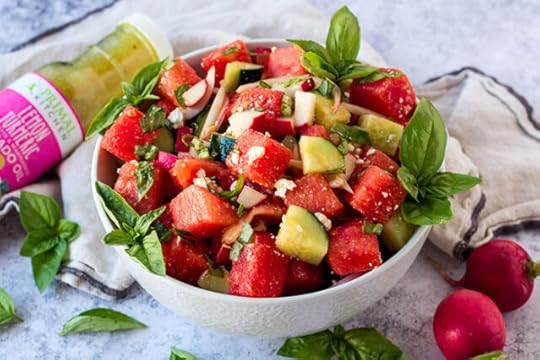 We can generally get our hands on a watermelon any time of year, but these are the months when they actually taste sweet and juicy. As soon as watermelons come into season, my Summer Watermelon Salad comes out of hiding. It’s a late summer treat that reminds us that even though we’re hearing the first whispers of school starting and pumpkin spice, it’s still summertime.
We can generally get our hands on a watermelon any time of year, but these are the months when they actually taste sweet and juicy. As soon as watermelons come into season, my Summer Watermelon Salad comes out of hiding. It’s a late summer treat that reminds us that even though we’re hearing the first whispers of school starting and pumpkin spice, it’s still summertime.
This watermelon salad is a sweet, crunchy, tangy accompaniment to any summer meal.
Tip: feel free to leave the feta cheese out if you are dairy-free, or replace it with goat cheese or fresh mozzarella.
Summer Watermelon Salad Recipe
Time in the kitchen: 5 minutes
Serves: 4
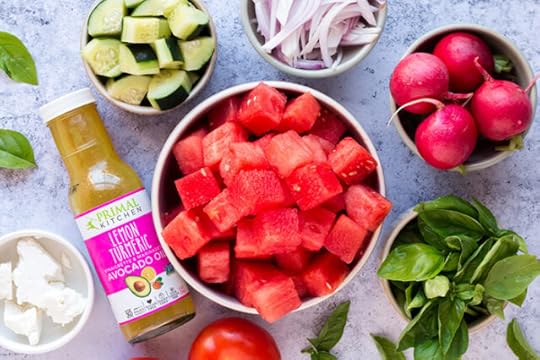
Ingredients
4 cups cubed watermelon
2 oz. crumbled feta cheese
1/4 cup basil
1 large tomato sliced into wedges
1 chopped cucumber
5 chopped radishes
1/3 cup sliced red onion
3 Tbsp. Primal Kitchen® Lemon Turmeric Dressing
salt and pepper
Directions
Chop the watermelon into ¾”-1” cubes. Slice the tomato into wedges and chop the cucumber and radishes.
 Thinly slice the red onion and the basil.
Thinly slice the red onion and the basil.
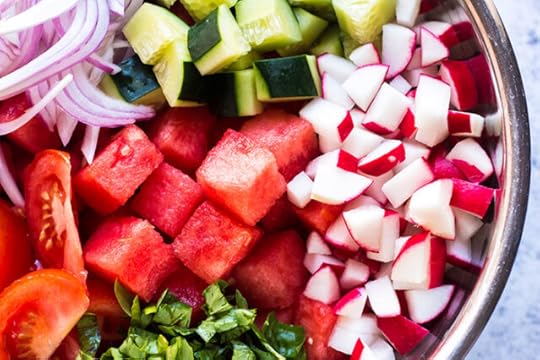
Combine the watermelon, chopped basil, tomato, cucumber, radishes and red onion in a bowl. Pour in the Primal Kitchen Lemon Turmeric Dressing and fold it into the salad along with the feta.
 Season with salt and pepper and garnish with more basil leaves.
Season with salt and pepper and garnish with more basil leaves.
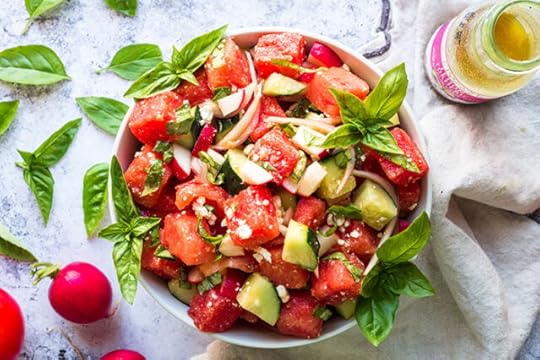
Nutrition Information (¼ of recipe):
Calories: 146
Fat: 6g
Total Carbohydrates: 19g
Net Carbohydrates: 17g
Protein: 5g
The post Summer Watermelon Salad Recipe appeared first on Mark's Daily Apple.



August 7, 2020
Weekly Link Love — Edition 93

Research of the Week
More evidence of admixture with ancient hominids.
Vegan and vegetarian weaning of infants is a real bad idea with potentially lasting effects.
In middle aged people, taking 5 grams of collagen every day improved language function and appeared to alter brain structure.
Using a very-low-carb ketogenic diet to reverse super high triglycerides.
Yogic pranayama breathing exercises have remarkable effects on anxiety and negative effect.
New Primal Blueprint Podcasts
Episode 438: Robb Wolf: Host Elle Russ chats with Robb Wolf about his new book.
Primal Health Coach Radio, Episode 72: Laura and Erin chat with Trudi Lebron.
Media, Schmedia
I always link to anything orangutan-related.
Interesting Blog Posts
A week on “the bean protocol.”
Social Notes
Everything Else
Modifying the human ACE2 receptor to prevent viral escape (and thus, proliferation).
Things I’m Up to and Interested In
Dire results: A recent study finds that UK women are incredibly deficient in a broad range of essential micronutrients.
I’m not surprised: Type 2 diabetic men with low testosterone do TRT and abolish their T2D.
I thought leaky gut was just a myth though: Restoring gut barrier function extends lifespan.
Article I found interesting: Literate but not numerate.
Drug that might actually help: IL-1 blocker blocks arthritis.
Question I’m Asking
Have you ever been consistent with breathing exercises? What have you noticed?
Recipe Corner
Crazy looking St. Paul Sandwich.
Get your thiamine: pork chop and apple skillet.
Time Capsule
One year ago (Aug 1 – Aug 7)
Menopause: Beyond the Stereotypes – Looking a bit further.
Are You Doing Microworkouts? Here’s Why You Should. – You really should be.
Comment of the Week
“But… Forrest Gump got COVID-19!”
-Good point, jeff.
The post Weekly Link Love — Edition 93 appeared first on Mark's Daily Apple.



Mark Sisson's Blog
- Mark Sisson's profile
- 199 followers











